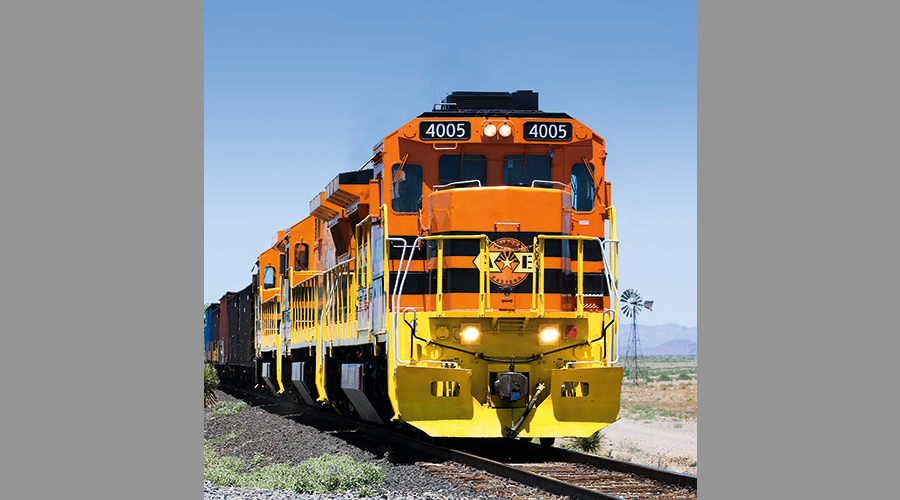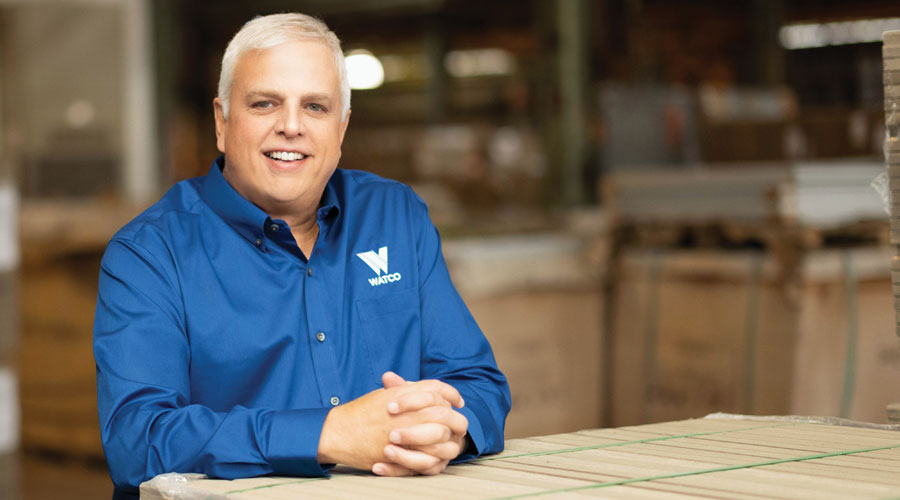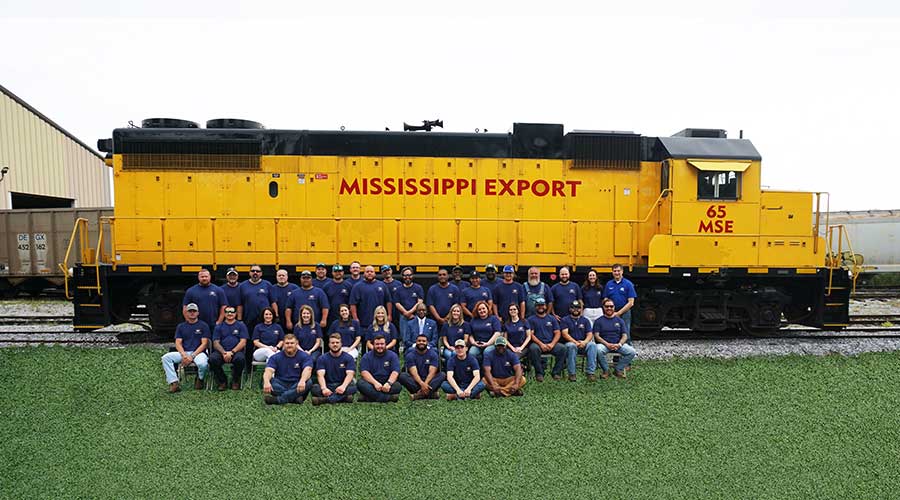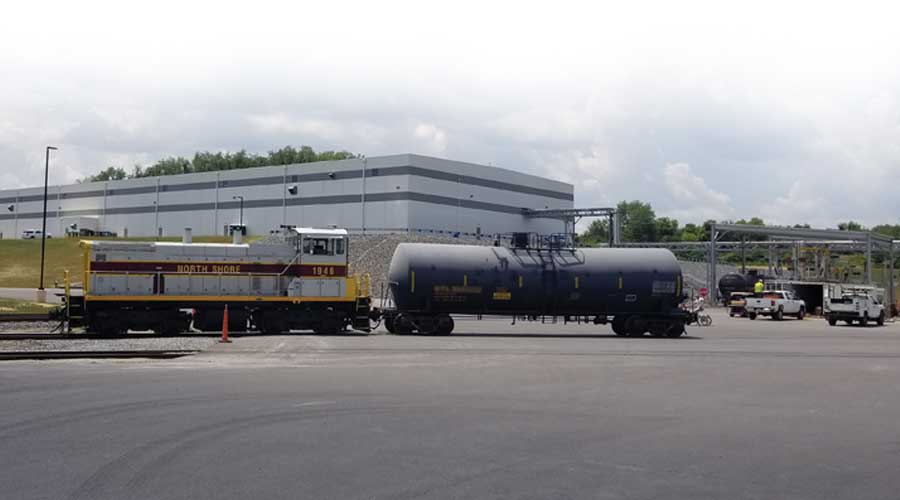Newsletter Sign Up
Stay updated on news, articles and information for the rail industry
Stay updated on news, articles and information for the rail industry
RAIL EMPLOYMENT & NOTICES
Rail News Home Short Lines & Regionals
Rail News: Short Lines & Regionals
Contact Progressive Railroading editorial staff.
November 2006
Rail News: Short Lines & Regionals
In short, a long-term traffic opportunity
advertisement
The U.S. government has been searching for domestic fuel sources to reduce dependence on foreign oil. For the past few years, a primary source has been ethanol, an alcohol produced from corn and other agricultural products that, when blended with gasoline, reduces the fuel’s costs and increases octane.
In 2004, about one-third of U.S. gasoline contained a 10 percent to 15 percent ethanol blend. Today, that figure is approaching half as more states require 10 percent to 20 percent blends.
And about three-quarters of the inbound materials used to produce ethanol, as well as the outbound ethanol and byproducts — such as distillers grains used as livestock feed — move by rail. Ethanol can’t be transported via pipelines because the grain alcohol degrades en route.
Three out of four loads by rail
In 2000, U.S. railroads and truckers split the traffic. Now, railroads move 75 percent; trucks, 20 percent; and barges, 5 percent. Railroads, which serve hundreds of grain elevators, are proving to producers that they can move ethanol quickly and cheaply over long distances, says Lou Jannazo, chief of project development for the Ohio Rail Development Commission.
Railroads that operate in Ohio soon will be moving more ethanol. There are dozens of plants proposed in the state.
“The striking thing is the ones we’re seeing are located on short lines,” says Jannazo.
U.S. Class Is are hauling more ethanol-related traffic — Union Pacific Railroad’s carloads rose 51 percent in the third quarter — but regionals and short lines are carrying more, too. As of Oct. 1, there were 103 U.S. ethanol plants, with another 46 under construction and dozens more proposed, many of which are located on small roads’ lines.
In Ohio, Harrison Ethanol L.L.C. plans to build a Harrison County plant along a Columbus and Ohio River Rail Road Co. line; Coshocton Ethanol L.L.C. will construct a Coshocton plant on an Ohio Central Railroad Inc. line; Cargill will build a Bloomingburg plant to be served by the Indiana & Ohio Railway Co.; and The Andersons Inc. is constructing a Greenville plant to be served by R.J. Corman Railroad.
“Short lines have better customer service than Class Is and don’t need big unit-train blocks,” says David Mears, senior director of equipment and service performance for the American Short Line and Regional Railroad Association (ASLRRA).
About half of the nation’s 500-plus regionals and short lines move ethanol-related traffic, and many more are interested in attracting plants to their lines, says Mears. More than 150 regional, short-line and other industry representatives attended a “Get Smart on Ethanol” seminar the association held Aug. 8 in Kansas City, Mo.
At the event, attendees learned domestic ethanol production has risen from 175,000 gallons in 1980 to an estimated 5 billion gallons in 2006. By 2015, production is projected to increase to 12.6 billion gallons.
One reason production is escalating: The U.S. Department of Energy banned the use of methyl tertiary-butyl (MBTE) as an unleaded gasoline additive in May. The department determined MBTE was a carcinogen and leached into groundwater.
“It’ll take about 2.7 billion gallons of ethanol to replace the MBTE,” says Dan Sabin, president of Iowa Northern Railway Co., which is just beginning to tap Iowa’s ethanol market.
The nation’s top ethanol-producing state at 1.5 billion gallons annually, Iowa is home to 25 plants. Twenty-four more are in the construction or planning stages, according to the Iowa Department of Transportation.
In May, Iowa Northern began serving its first plant: a 120-million-gallon-capacity facility built by Hawkeye Renewables in Fairbank.
“Typically, a 100 million-gallon plant means 3,500 carloads of ethanol, 3,500 carloads of distillers grains and 2,000 carloads of corn annually to a railroad,” says Sabin.
Coming soon: More carloads
This month, Hawkeye Renewables will begin building a second 120-million-gallon, Iowa Northern-served plant in Shell Rock.
“They’re also considering whether to build more plants on our line,” says Sabin.
The 163-mile short line’s numerous rail connections are attracting producers, he says. The railroad interchanges with UP, BNSF Railway Co., Canadian National Railway Co., Iowa Interstate Railroad Ltd., the Dakota, Minnesota & Eastern and Iowa, Chicago and Eastern railroads, and Cedar Rapids and Iowa City Railroad Co.
And soon, Iowa Northern will have more capacity to handle ethanol carloads. Last month, the Federal Railroad Administration approved the railroad’s $25.5 million Railroad Rehabilitation and Improvement Financing loan, part of which the short line will use to upgrade track for ethanol and biofuels traffic (for more information, see Short Line/Regional News).
Iowa Northern expects to begin moving more ethanol carloads in April 2007, when Manly Terminal L.L.C. opens the first phase of an ethanol distribution center in Manly, Iowa. The truck-to-rail facility is designed to store 20 million gallons of ethanol for several producers.
“We need more termination points for ethanol unit trains, and in five years, we plan to develop 20 to 25 termination points with other short lines,” says Sabin.
One of those short lines could be a new railroad. Earlier this year, officials at Pine Lake Corn Processors L.L.C. were trying to find a way to move ethanol via rail instead of truck from the company’s year-old plant in Steamboat Rock, Iowa. The solution: start up a short line. In June, Pine Lake — along with partners Railroad Material Salvage Inc., Prairie Land Cooperative and United Suppliers Inc. — launched Iowa River Railroad, a short line operating 41 track miles between Ackley and Marshalltown.
“As part owner, we know we’re getting cars in and out in a timely manner,” says Pine Lake General Manager Scott Zabler. “We have the flexibility to interchange with CN and UP, which opens us up to many markets and potential overseas markets.”
Pine Lake upgraded a 10-mile line between Ackley and Eldora for the short line, which also moves grain for Prairie Land, fertilizer for United Suppliers and plastic pellets. Iowa River began moving ethanol from the 20 million-gallon plant in late October, enabling Pine Lake to move 85 percent of its ethanol via rail to a CN or UP interchange instead of by truck to an Ackley rail loading facility, says Zabler.
Opportunities great in Badger State
Meanwhile, Wisconsin & Southern Railroad Co. (WSOR) is hauling the majority of ethanol-related freight from plants in Oshkosh and Monroe, Wis. And within three years, the 700-mile regional could be serving as many as eight ethanol plants.
“Producers are finding there’s a lot of corn in Wisconsin,” says WSOR President Bill Gardner. “Our lines have 24 rail-served grain elevators.”
In February 2007, WSOR will begin serving a new Milton plant. By late 2007 or early 2008, the regional also will start serving plants in Arena and Cambria. Gardner expects ethanol accounts to generate 10,000 inbound and outbound carloads in 2007.
“If you would have told me four years ago that I’d be serving two ethanol plants, I would have said, ‘Halleujah!’” he says.
The only thing that might curb small railroaders’ enthusiasm about ethanol’s traffic potential is a tight tank-car supply. There might not be enough cars to go around as more plants open, says ASLRRA’s Mears.
“We heard from one major tank-car manufacturer that they’re booked up until 2008,” he says.
In 2004, about one-third of U.S. gasoline contained a 10 percent to 15 percent ethanol blend. Today, that figure is approaching half as more states require 10 percent to 20 percent blends.
And about three-quarters of the inbound materials used to produce ethanol, as well as the outbound ethanol and byproducts — such as distillers grains used as livestock feed — move by rail. Ethanol can’t be transported via pipelines because the grain alcohol degrades en route.
Three out of four loads by rail
In 2000, U.S. railroads and truckers split the traffic. Now, railroads move 75 percent; trucks, 20 percent; and barges, 5 percent. Railroads, which serve hundreds of grain elevators, are proving to producers that they can move ethanol quickly and cheaply over long distances, says Lou Jannazo, chief of project development for the Ohio Rail Development Commission.
Railroads that operate in Ohio soon will be moving more ethanol. There are dozens of plants proposed in the state.
“The striking thing is the ones we’re seeing are located on short lines,” says Jannazo.
U.S. Class Is are hauling more ethanol-related traffic — Union Pacific Railroad’s carloads rose 51 percent in the third quarter — but regionals and short lines are carrying more, too. As of Oct. 1, there were 103 U.S. ethanol plants, with another 46 under construction and dozens more proposed, many of which are located on small roads’ lines.
In Ohio, Harrison Ethanol L.L.C. plans to build a Harrison County plant along a Columbus and Ohio River Rail Road Co. line; Coshocton Ethanol L.L.C. will construct a Coshocton plant on an Ohio Central Railroad Inc. line; Cargill will build a Bloomingburg plant to be served by the Indiana & Ohio Railway Co.; and The Andersons Inc. is constructing a Greenville plant to be served by R.J. Corman Railroad.
“Short lines have better customer service than Class Is and don’t need big unit-train blocks,” says David Mears, senior director of equipment and service performance for the American Short Line and Regional Railroad Association (ASLRRA).
About half of the nation’s 500-plus regionals and short lines move ethanol-related traffic, and many more are interested in attracting plants to their lines, says Mears. More than 150 regional, short-line and other industry representatives attended a “Get Smart on Ethanol” seminar the association held Aug. 8 in Kansas City, Mo.
At the event, attendees learned domestic ethanol production has risen from 175,000 gallons in 1980 to an estimated 5 billion gallons in 2006. By 2015, production is projected to increase to 12.6 billion gallons.
One reason production is escalating: The U.S. Department of Energy banned the use of methyl tertiary-butyl (MBTE) as an unleaded gasoline additive in May. The department determined MBTE was a carcinogen and leached into groundwater.
“It’ll take about 2.7 billion gallons of ethanol to replace the MBTE,” says Dan Sabin, president of Iowa Northern Railway Co., which is just beginning to tap Iowa’s ethanol market.
The nation’s top ethanol-producing state at 1.5 billion gallons annually, Iowa is home to 25 plants. Twenty-four more are in the construction or planning stages, according to the Iowa Department of Transportation.
In May, Iowa Northern began serving its first plant: a 120-million-gallon-capacity facility built by Hawkeye Renewables in Fairbank.
“Typically, a 100 million-gallon plant means 3,500 carloads of ethanol, 3,500 carloads of distillers grains and 2,000 carloads of corn annually to a railroad,” says Sabin.
Coming soon: More carloads
This month, Hawkeye Renewables will begin building a second 120-million-gallon, Iowa Northern-served plant in Shell Rock.
“They’re also considering whether to build more plants on our line,” says Sabin.
The 163-mile short line’s numerous rail connections are attracting producers, he says. The railroad interchanges with UP, BNSF Railway Co., Canadian National Railway Co., Iowa Interstate Railroad Ltd., the Dakota, Minnesota & Eastern and Iowa, Chicago and Eastern railroads, and Cedar Rapids and Iowa City Railroad Co.
And soon, Iowa Northern will have more capacity to handle ethanol carloads. Last month, the Federal Railroad Administration approved the railroad’s $25.5 million Railroad Rehabilitation and Improvement Financing loan, part of which the short line will use to upgrade track for ethanol and biofuels traffic (for more information, see Short Line/Regional News).
Iowa Northern expects to begin moving more ethanol carloads in April 2007, when Manly Terminal L.L.C. opens the first phase of an ethanol distribution center in Manly, Iowa. The truck-to-rail facility is designed to store 20 million gallons of ethanol for several producers.
“We need more termination points for ethanol unit trains, and in five years, we plan to develop 20 to 25 termination points with other short lines,” says Sabin.
One of those short lines could be a new railroad. Earlier this year, officials at Pine Lake Corn Processors L.L.C. were trying to find a way to move ethanol via rail instead of truck from the company’s year-old plant in Steamboat Rock, Iowa. The solution: start up a short line. In June, Pine Lake — along with partners Railroad Material Salvage Inc., Prairie Land Cooperative and United Suppliers Inc. — launched Iowa River Railroad, a short line operating 41 track miles between Ackley and Marshalltown.
“As part owner, we know we’re getting cars in and out in a timely manner,” says Pine Lake General Manager Scott Zabler. “We have the flexibility to interchange with CN and UP, which opens us up to many markets and potential overseas markets.”
Pine Lake upgraded a 10-mile line between Ackley and Eldora for the short line, which also moves grain for Prairie Land, fertilizer for United Suppliers and plastic pellets. Iowa River began moving ethanol from the 20 million-gallon plant in late October, enabling Pine Lake to move 85 percent of its ethanol via rail to a CN or UP interchange instead of by truck to an Ackley rail loading facility, says Zabler.
Opportunities great in Badger State
Meanwhile, Wisconsin & Southern Railroad Co. (WSOR) is hauling the majority of ethanol-related freight from plants in Oshkosh and Monroe, Wis. And within three years, the 700-mile regional could be serving as many as eight ethanol plants.
“Producers are finding there’s a lot of corn in Wisconsin,” says WSOR President Bill Gardner. “Our lines have 24 rail-served grain elevators.”
In February 2007, WSOR will begin serving a new Milton plant. By late 2007 or early 2008, the regional also will start serving plants in Arena and Cambria. Gardner expects ethanol accounts to generate 10,000 inbound and outbound carloads in 2007.
“If you would have told me four years ago that I’d be serving two ethanol plants, I would have said, ‘Halleujah!’” he says.
The only thing that might curb small railroaders’ enthusiasm about ethanol’s traffic potential is a tight tank-car supply. There might not be enough cars to go around as more plants open, says ASLRRA’s Mears.
“We heard from one major tank-car manufacturer that they’re booked up until 2008,” he says.
— Jeff Stagl
Keywords
Browse articles on ethanol ethanol traffic Iowa Northern Railway Pine Lake Corn Wisconsin & SouthernContact Progressive Railroading editorial staff.


 2025 MOW Spending Report: Passenger-rail programs
2025 MOW Spending Report: Passenger-rail programs
 Gardner steps down as Amtrak CEO
Gardner steps down as Amtrak CEO
 Guest comment: Oliver Wyman’s David Hunt
Guest comment: Oliver Wyman’s David Hunt
 Women of Influence in Rail eBook
Women of Influence in Rail eBook
 railPrime
railPrime







